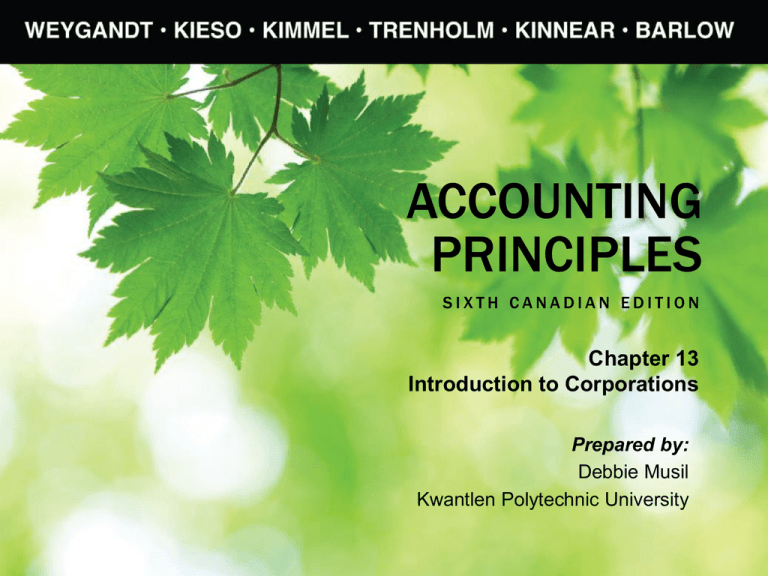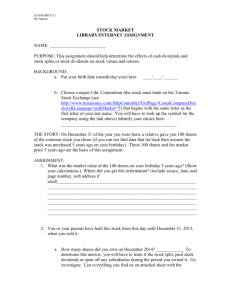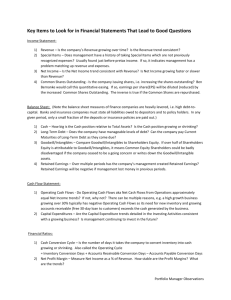
ACCOUNTING
PRINCIPLES
SIXTH CANADIAN EDITION
Chapter 13
Introduction to Corporations
Prepared by:
Debbie Musil
Kwantlen Polytechnic University
Introduction to Corporations
• The corporate form of organization
– Characteristics
– Operating a corporation
• Share capital
– Issuing shares
– Preferred shares
• Retained earnings
– Corporate income statements
– Cash dividends
– Reporting retained earnings
• Statement presentation and analysis
Copyright John Wiley & Sons Canada, Ltd.
2
CHAPTER 13:
Introduction to Corporations
STUDY OBJECTIVES:
1. Identify and discuss characteristics of the
corporate form of organization.
2. Account for the issuance of common and
preferred shares.
3. Prepare a corporate income statement.
4. Account for cash dividends.
5. Prepare a statement of retained earnings and
closing entries for a corporation.
6. Prepare the shareholders’ section of the balance
sheet and calculate return on equity.
Copyright John Wiley & Sons Canada, Ltd.
3
The Corporate Form of
Organization
• A legal entity separate from its owners
(known as shareholders)
• Classified by purpose and ownership:
– Purpose: for profit or not-for-profit
– Ownership:
• Public corporation: shares are available for
purchase on an organized securities market
• Private corporation: shares are held by a few
individuals and are not traded
Copyright John Wiley & Sons Canada, Ltd.
4
Characteristics of a
Corporation
• Separate legal existence from its owners
– Acts under its own name
– Owners do not bind the corporation
• Limited liability of shareholders
– Limited to the amount of their investment
• Transferable ownership rights
– Shares may be bought and sold
– No effect on operating activities of corporation
• Ability to acquire capital
– Can raise capital by issuing shares
– May be difficult for closely-held corporations
Copyright John Wiley & Sons Canada, Ltd.
5
Characteristics of a Corporation 2
• Continuous and unlimited life
– Unaffected by change in ownership
• Government regulations
– Specific laws that govern operations of
corporations
• Income tax
– Taxed as a separate entity
Copyright John Wiley & Sons Canada, Ltd.
6
Forming a Corporation
• Can incorporate federally or provincially
• Done by filing articles of incorporation (the
company’s “constitution”):
– Provide information such as :
• Name and purpose of company
• Number of shares and kinds of shares
• Location of corporation’s head office
• By-laws: internal rules and policies
• Organization costs:
– Costs of forming a corporation
– Must be expensed when incurred
Copyright John Wiley & Sons Canada, Ltd.
7
Ownership Rights of
Shareholders
• Ownership rights are in the form of
shares
– Can be divided into different classes
• As stated in the articles of incorporation
• Each class has rights and privileges
• Usually referred to as common and preferred
shares
• Shareholders have rights:
– To vote on certain matters
– To dividends: the distribution of profit
– To remaining assets in a liquidation
Copyright John Wiley & Sons Canada, Ltd.
8
Corporation Management
• Shareholders manage the corporation
through the Board of Directors that
they elect
• The board:
– Decides on the corporation’s operating
policies
– Selects officers (such as the Chief
Executive Officer or CEO) to perform
daily management functions
9
CHAPTER 13:
Introduction to Corporations
STUDY OBJECTIVES:
1. Identify and discuss characteristics of the
corporate form of organization.
2. Account for the issuance of common and
preferred shares.
3. Prepare a corporate income statement.
4. Account for cash dividends.
5. Prepare a statement of retained earnings and
closing entries for a corporation.
6. Prepare the shareholders’ section of the balance
sheet and calculate return on equity.
Copyright John Wiley & Sons Canada, Ltd.
10
Share Issue Considerations
• Authorized share capital
– Number of shares company is allowed to
sell
– Many companies have unlimited number
of shares
• Issue of shares
– Issued directly to investors or through an
investment dealer
– First public sale is called an initial public
offering (IPO)
Copyright John Wiley & Sons Canada, Ltd.
11
Share Issue Considerations 2
• Market value of shares
– Once issued, shares trade on a
secondary market
– Prices determined by buyers and sellers
and other external factors
• Legal capital
– Share capital is legal capital and cannot
be distributed to shareholders
– Retained earnings are earned capital
and can be distributed as dividends
Copyright John Wiley & Sons Canada, Ltd.
12
Common Shares:
Issuing Shares
• Shares are usually issued for cash:
Dr. Cash
Cr. Common shares
• Shares can be issued in exchange for
services or noncash assets
– Recorded at fair value of goods/services
received:
Dr. Service or asset (e.g. Legal Fees Expense)
Cr. Common shares
– Under IFRS, if fair value of goods/services not
measurable, use fair value of shares given up
– Under ASPE, can use either of the above
valuation methods
Copyright John Wiley & Sons Canada, Ltd.
13
Preferred Shares
• Priority over common shares for
dividends and assets in the event of
liquidation of the company
• Entries to record issue and
reacquisition of preferred shares
similar to entries for common shares
• Transactions for each class of share
is recorded in a separate account
Copyright John Wiley & Sons Canada, Ltd.
14
Dividend Preference
• Preferred shareholders have a right to
dividends before common shareholders
• Cumulative preferred shares have a right to
current year’s dividends and any prior
years’ dividends owing before dividends
are paid on common shares
• Any unpaid dividends (in arrears) are not
considered a liability
– No obligation to pay unless dividend is declared
Copyright John Wiley & Sons Canada, Ltd.
15
Convertible Preferred Shares
• Provide option to exchange preferred shares to
common shares at a specified ratio
• Conversion is recorded by transferring cost from
Preferred Shares to Common Shares account
Copyright John Wiley & Sons Canada, Ltd.
16
Redeemable and Retractable
Preferred Shares
• Corporation (redeemable) or the
shareholder (retractable) can redeem the
shares at specified future dates and prices
• Similar to debt: offers a repayment of the
principal
• Considered a financial instrument
• These preferred shares usually reported in
the liabilities section of the balance sheet
Copyright John Wiley & Sons Canada, Ltd.
17
CHAPTER 13:
Introduction to Corporations
STUDY OBJECTIVES:
1. Identify and discuss characteristics of the
corporate form of organization.
2. Account for the issuance of common and
preferred shares.
3. Prepare a corporate income statement.
4. Account for cash dividends.
5. Prepare a statement of retained earnings and
closing entries for a corporation.
6. Prepare the shareholders’ section of the balance
sheet and calculate return on equity.
Copyright John Wiley & Sons Canada, Ltd.
18
Retained Earnings
• The cumulative total of profit less losses and less
declared dividends since incorporation
• Represents part of shareholder’s claim on total
assets of a corporation
– Not a claim on any specific asset (including cash)
• Two major components:
– Profit
– Dividends: cash distributions to owners
Copyright John Wiley & Sons Canada, Ltd.
19
Corporate Income
Statements
• Income statement for corporations are
similar to proprietorship or partnership
statements
• One major difference is income taxes
– Since corporation is a separate legal entity
– Affects income statement (income tax expense)
and balance sheet (income tax payable or
receivable)
Copyright John Wiley & Sons Canada, Ltd.
20
Corporate Income Statements 2
Copyright John Wiley & Sons Canada, Ltd.
21
CHAPTER 13:
Introduction to Corporations
STUDY OBJECTIVES:
1. Identify and discuss characteristics of the
corporate form of organization.
2. Account for the issuance of common and
preferred shares.
3. Prepare a corporate income statement.
4. Account for cash dividends.
5. Prepare a statement of retained earnings and
closing entries for a corporation.
6. Prepare the shareholders’ section of the balance
sheet and calculate return on equity.
Copyright John Wiley & Sons Canada, Ltd.
22
Dividends
• Pro-rata distribution of a portion of
corporation’s retained earnings to
shareholders
– Pro-rata: based on the proportion of
shares owned
• Common types of dividends
• Cash dividends
• Stock dividends (normally common shares)
Copyright John Wiley & Sons Canada, Ltd.
23
Cash Dividends
• To pay dividends, a corporation must:
– Have enough retained earnings and cash
– Declare a dividend payable
• Declaration date:
– Board of directors formally declares dividend
– Commits company to a legal obligation
– Declaration is recorded:
Copyright John Wiley & Sons Canada, Ltd.
24
Cash Dividends 2
• Record date:
– Ownership of shares is determined
– Shareholders of record on this date will receive
dividend
– No journal entry required
• Payment date:
– Dividend is paid to shareholders and recorded:
Copyright John Wiley & Sons Canada, Ltd.
25
CHAPTER 13:
Introduction to Corporations
STUDY OBJECTIVES:
1. Identify and discuss characteristics of the
corporate form of organization.
2. Account for the issuance of common and
preferred shares.
3. Prepare a corporate income statement.
4. Account for cash dividends.
5. Prepare a statement of retained earnings and
closing entries for a corporation.
6. Prepare the shareholders’ section of the balance
sheet and calculate return on equity.
Copyright John Wiley & Sons Canada, Ltd.
26
Statement of Retained
Earnings
• Shows the changes in retained
earnings during the year
• Required under ASPE
• Transactions that affect retained
earnings:
– Earning a profit (incurring a loss)
– Declaring cash and stock dividends
– Other transactions
Copyright John Wiley & Sons Canada, Ltd.
27
Sample Statement of Retained
Earnings
Copyright John Wiley & Sons Canada, Ltd.
28
CHAPTER 13:
Introduction to Corporations
STUDY OBJECTIVES:
1. Identify and discuss characteristics of the
corporate form of organization.
2. Account for the issuance of common and
preferred shares.
3. Prepare a corporate income statement.
4. Account for cash dividends.
5. Prepare a statement of retained earnings and
closing entries for a corporation.
6. Prepare the shareholders’ section of the balance
sheet and calculate return on equity.
Copyright John Wiley & Sons Canada, Ltd.
29
Shareholders’ Equity on the
Balance Sheet
• Contributed Capital
– Share capital: preferred and common shares
– Contributed surplus: amounts contributed from
acquiring and retiring shares
• Retained Earnings
– Cumulative profit (loss) since incorporation
– Annual profit (loss) is added (deducted);
dividends are deducted
• Accumulated Other Comprehensive
Income
– Used by companies that follow IFRS (not
ASPE)
Copyright John Wiley & Sons Canada, Ltd.
30
Sample Shareholders’ Equity Section
Copyright John Wiley & Sons Canada, Ltd.
31
Return on Equity
• Also called return on investment
• Considered to be the most important
measure of a firm’s profitability
• It evaluates how many dollars are earned
for each dollar invested by shareholders
Copyright John Wiley & Sons Canada, Ltd.
32
Copyright
Copyright © 2013 John Wiley & Sons Canada, Ltd. All rights
reserved. Reproduction or translation of this work beyond
that permitted by Access Copyright (the Canadian copyright
licensing agency) is unlawful. Requests for further
information should be addressed to the Permissions
Department, John Wiley & Sons Canada, Ltd. The purchaser
may make back-up copies for his or her own use only and
not for distribution or resale. The author and the publisher
assume no responsibility for errors, omissions, or damages
caused by the use of these files or programs or from the use
of the information contained herein.
Prepared by:
A. Davis, MSc, BComm, CA, CFE
Copyright John Wiley & Sons Canada, Ltd.






